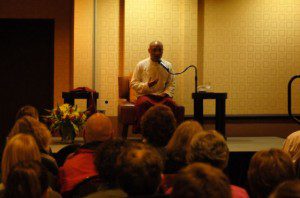
My friend Jeffrey Kotyk* of the Flower Ornament Depository 華嚴藏 blog has another interesting post worth reading this week, discussing the visibility, if not overall popularity of Tibetan Buddhism in America. His post is titled Why is Tibetan Buddhism more popular?
As you can see by my title, I’m not so sure that it is, though I wouldn’t be surprised if Tibetan Buddhism as a whole had more adherents in America than Theravadin or Zen. But the methodology of counting who’s who gets tough. Do we count Seon and Ch’an practitioners with the Zen? And do all of the ‘mindfulness’ practitioners, followers of Kornfield and Kabat-Zinn, somehow fit into Theravadin (some might self-affiliate with it, some might not). However, difficulties with methodology and categories shouldn’t stand in the way of thoughtful discussion and fruitful research.
(I wrote about the broad issue of Buddhists in America recently here.) Jeffrey notes about a dozen reasons he thinks Tibetan Buddhism is most popular (I’ll liberally paraphrase them – see his postfor the full discussion). And I note that he is particularly comparing Tibetan Buddhism here with other forms of Mahayana Buddhism, but I think it’s fair to toss in Theravada:
- The volume of printed materials on Tibetan Buddhism is greatest and most accessible to non-specialists.
- More Western students are going Tibetan institutes in India than to East Asia (I imagine Theravadin countries get more ‘religious-scholar tourism’ than East Asian ones, but still less than the Tibetan institutions in India).
- Specificially, Taiwanese Buddhist organizations Foguang Shan and Dharma Drum Mountain have great resources, yet less than two dozen Western monastics.
- Tibetan teachers (e.g. HH the Dalai Lama) draw larger crowds of committed students.
- Tibetan groups are working on the 84,000 Project, an ambitious plan to translate the Tibetan canon, and actively training translators; there is nothing comparable for the East Asian canon.
- Perhaps the teaching curriculum? Lama Tsongkhapa’s Lam Rim Chen Mo (Great Treatise on the Stages of the Path) is a simple go-to for Gelugpas. Chinese and Japanese don’t have anything quite like this. Theravadins have the Visuddhimagga, but it doesn’t seem to have been popularized in the way that the Lam Rim Chen Mo, or Mipham’s “Lamp” have, or works like those of Shantideva or even Atisha.
- Tibetan Buddhists speak English – many big names at least, while East Asian big names often don’t.
- Tibetan Buddhism “is not heavily tied to an immigrant ethnicity unlike, say, Chinese Buddhism which is very closely tied to a specific ethnic group. Chinese Buddhist traditions might even specifically promote themselves as exclusively “Chinese Buddhist” and in the process exclude members of the host culture.” – This I quote specifically because I don’t think it’s accurate – based at least on various accounts and my limited time at Hsi Lai Temple in Los Angeles.
- Tibetans have been engaging scientists in fruitful discussion.
- East Asian monastic life is difficult for Westerners (inaccessible, too foreign, strict, etc).
- Tibetan culture is generally more relaxed than Chinese, e.g. prostrations, prescribed forms for how to bow, prostrate, salute, eat and walk.
- Tibetan Buddhism “has a tradition of debate and it is not considered impolite to engage in it with your superiors.”
Again, see his post for more on each of his points.
As I mentioned, I’m not entirely sure Tibetan Buddhism is the most popular form of Buddhism in the West, or even Mahayana Buddhism (although I agree with Jeffrey in suspecting that it is). I think his work is commendable in it’s thoughtful approach to the topic and what I hope to get from you is some feedback and thoughts. Where you live are there more Tibetan groups? A city full of Theravadins or six different Zen groups? I can’t hope to amass anything approaching a systematic survey, but perhaps a small and hopefully reasonably representative sample could be gathered.
One interesting statistic that most of us overlook is that there are more than an estimated 300,000 SGI members in the US (See Prebish: Looking West: A Primer for American Buddhism). If we pick a low estimate for total Buddhists, say one million, then they are very likely the largest single group. But if we estimate high, perhaps six million Buddhists, then SGI is but a small part of that picture. Obviously this is a question dying to be answered, however tentatively, by some earnest young scholar who is able and willing to go do the polling.
If indeed Tibetan Buddhism is the most popular, I would like to have seen some discussion of the diaspora as a key underlying ingredient. Tibetans HAD to leave Tibet, HAD to learn new systems and HAD to attract foreign benefactors in order to survive and maintain a semblance of the culture and life they knew for centuries in Tibet. They HAD to be more flexible in adopting different techniques and norms regarding teaching and ediquette.
At the same time, I think there are real cultural differences that may have played a part. Tibetans are, typically, quite funny and fun-loving people. I recall one Independent Study I read while on the Antioch program in India that was devoted entirely to Tibetan humor – something that the author found utterly unique amongst the many different Buddhists she encountered in Bodh Gaya. This has been my experience as well.
I’m also not so sure about how ‘easy’ Tibetan monasticism is compared to that of East Asia. Certainly there are some images of rather brutal conditions in Zen monasteries, but Tibetan monastic life is no picnic, and there are Zen orders that are notably more relaxed (the Order of Buddhist Contemplatives is one such Zen group that has attracted Western monastics in the US and UK.) And in terms of texts, Suzuki Roshi’s Zen Mind, Beginner’s Mind has probably outsold every living Tibetan author combined over the last 40 years (that is very conjectural and I’m happy to be corrected). But Zen and Zen-inspired works were the big thing in the 60s and 70s. True, none of these works were anything like the systematic philosophical works of Tsongkhapa or Buddhaghosa, but many were, in their own way, ‘complete’ textual guides.
But these are only minor objections. Again, I’m hoping to hear back from you (readers), on both what types of Buddhism are practiced near you (feel free to be creative in how you choose to classify/categorize them) and why you think this is.
If Jeffrey is correct, and I suspect he is, then East Asian (and South Asian) Buddhists might want to change some of their strategies for winning over new Buddhists and monastics in and from the West.
*I last mentioned Jeffrey in discussing his fascinating idea to use the Google NGram to trace the rise and fall of Buddhim – in search.











